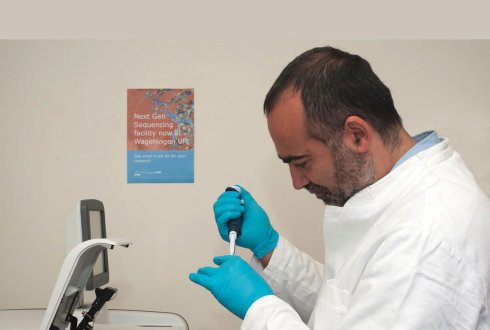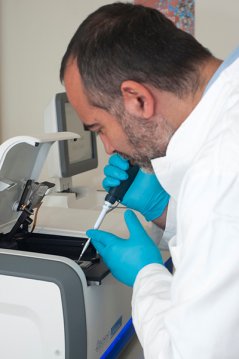Wageningen, The Netherlands
May 19, 2015

Wageningen UR recently invested in optical mapping equipment for DNA analyses. This will enable Wageningen UR and its partner research institutions and companies to map the full DNA sequence of various plants better and faster, enhancing the accuracy of crop breeding. The equipment will be part of the CAT-AgroFood shared research facilities on the Wageningen Campus, which opens up Wageningen UR’s facilities to scientists from other knowledge institutes and companies.
The acquisition of advanced equipment for the optical mapping of plant genomes will give research at Wageningen UR and other Dutch knowledge institutes a major boost. The new Irys System by Bionano Genomics improves existing genomes eliminating gaps in their assemblies. This allows breeding programmes to predict the ideal varieties for crossing and the characteristics of future mature plants from seedlings with far greater precision than before.
Using the new analysis equipment, scientists can map the genome – the collection of all the hereditary properties of a living organism – more quickly and accurately than before. This information enables precision breeding as each component of the billions of building blocks in a genome can be identified. Sometimes clear differences in the characteristics of crops, such as red or yellow tomatoes, depend on subtle deviations in the genome. The genome analysis system can deal with complex genomes, including several economically important crops such as the tomato and potato. Other crops that are still waiting to be analysed are the banana, melon and lettuce.

Genome analysis is the field of Gabino Sanchez Perez, head of the Applied Bioinformatics department, which is where research into the genomes of crops at Wageningen UR is focused. “The existing reference maps of many genomes still contain multiple uncertainties, gaps and duplications. The new equipment allows us to make high quality genome maps and, even more importantly, unravel sections of the genome that are related to valuable features, such as the content of healthy substances.” In addition, there are complex plant genomes for which standard equipment cannot provide a clear picture – this includes crops which have a lot of repetitive stretches of DNA with many variations. “The new system lets us analyse these previously ‘inaccessible’ genomes; and not just individual genomes, but entire populations.”
The group already has the first results of an analysis of the comprehensive DNA of a wild relative of the tomato. “This took two weeks,” reports Sanchez-Perez. “With the old technology it would have cost us two months.” Several other groups within Wageningen UR are now building up expertise with the technology, especially in the fields of bioinformatics, biosystematics and genetics.
The Irys equipment will initially be used to improve the various genome maps of the tomato. This will have an immediate positive effect on the speed of tomato breeding. It will, for example, allow tomato plants that also deliver high food yields in poor growing conditions to be developed more quickly.
The technology is valuable in other areas of research, too. For example, cancer researchers have shown interest in using the new equipment in Wageningen. Studies on small variations in human DNA and their effects on health are still often a complex component of broader research into such diseases. Wageningen UR’s optical mapping equipment is helpful in this regard.
Length of read
The main obstacle in genome sequencing is the limited DNA read length, i.e. the maximum length of DNA fragments that can be read without many mistakes. The Irys System by Bionano Genomics, which featured among the top 10 innovations in The Scientist last year, unravels DNA strands from thousands to a million DNA building blocks and automatically lays overlapping pieces parallel to each other. This makes the DNA puzzle much easier to solve.
CAT-AgroFood
The new equipment represents a significant expansion of the existing genome sequence systems. It is part of the next generation sequencing systems (NGS) within Wageningen UR’s CAT-AgroFood shared research facilities, which are also open to other organisations. CAT-AgroFood is an initiative by the Dutch Ministry of Economic Affairs and the Province of Gelderland, each of which provides a financial contribution, and Wageningen UR, which contributes input from equipment in kind.
The combination of sophisticated facilities – the Irys system, PacBio RS II (an NGS technology), and a flow cytometer cell sorter for DNA isolation and complementary equipment – means that Wageningen UR offers a unique setting in which genomes can be both isolated and analysed at a cost which can usually not be matched elsewhere.